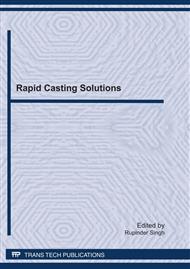[1]
P. C. Pandey and H. S. Shan: Modern Machining Processes (1980), 79-80 (Tata McGraw-Hill Publishing Company, New York).
Google Scholar
[2]
R. Kern : Improving Wire-EDM Productivity, EDM Today (2007), March/April Issue.
Google Scholar
[3]
W. M. Wang and K. P. Rajurkar: Monitoring Sparking Frequency and Predicting Wire Breakage in WEDM, Sensors and Signal processing for Manufacturing, American Society of mechanical engineer Production engineering division (PED) New York Vol. 51 (1992).
Google Scholar
[4]
N. Kinoshita, M. fakui, G. Gamo: Control of Wire–EDM Preventing from Breaking, CIRP ANN Vol. 31(1) (1982), 11-114.
DOI: 10.1016/s0007-8506(07)63279-x
Google Scholar
[5]
S. Banerjee, B. V. Parshad, P. K. Mishra: A simple model to estimate the thermal load on EDM wire electrode, J. Mater. Process. Technol Vol. 39 (1993), 305-317.
DOI: 10.1016/0924-0136(93)90165-3
Google Scholar
[6]
Y. S. Liao, Y. Chu, M.T. Yan: Study of wire breaking process and monitoring of WEDM, Int. J. Mach. Tool's manuf Vol. 37(4) (1997), 555-557.
Google Scholar
[7]
M. T. Yan and Y.S. Liao: Monitoring and self–learning fuzzy control for wire rupture prevention in wire electrical discharge machining, Int. J. Mach. Tool's manuf Vol. 36(3) (1996), 339-353.
DOI: 10.1016/0890-6955(95)00050-x
Google Scholar
[8]
K. P. Rajurkar and W. M. Wang: Thermal modeling and on-line monitoring of wire-EDM, J. Mater. Process. Technol (1993), 417-430.
Google Scholar
[9]
F. Han, G. Cheng, Z. Feng, S. Isago: Thermo-mechanical analysis and optimal tension control of micro wire electrode, International Journal of Machine Tool and Manufacture Vol. 48 (2008), 922-938.
DOI: 10.1016/j.ijmachtools.2007.10.024
Google Scholar
[10]
N. Tosun and C. Cogun: An investigstion on wire wear in WEDM, Journal of Materials Processing technology Vol. 134 (2003), 273-278.
DOI: 10.1016/s0924-0136(02)01045-2
Google Scholar
[11]
A. Okada, Y. Uno, M. Nakazawa, T. Yamauchi: Evaluations of spark distribution and wire vibration in wire EDM by high speed observation, CIRP Annals-manufacturing Technology Vol. 59 ( 2010), 231-234.
DOI: 10.1016/j.cirp.2010.03.073
Google Scholar
[12]
S. Aoyama, K. Tamura, T. Sato: High-performance coated wire electrodes for high-speed cutting and accurate machining, Hitachi Cable Review (1999), 18.
Google Scholar
[13]
A. Bensely, S. Venkatesh, D. Mohan Lal, G. Nagarajan, A. Rajadurai, K. Junik: Effect of cryogenic treatment on distribution of residual stress in case carburized En 353 steel, Mater Sci Eng A Vol 479(1) (2008), 229–235.
DOI: 10.1016/j.msea.2007.07.035
Google Scholar
[14]
K. Moore and D. N. Collins: Cryogenic treatment of three heat treated tool steels, Key Engineering Materials Vol. 47 (1993), 86–87.
DOI: 10.4028/www.scientific.net/kem.86-87.47
Google Scholar
[15]
A. Molinari, M. Pellizzari, S. Gialenella, G. Straffelini, K. H. Stiasny: Effect of deep cryogenic treatment on the mechanical properties of tool steels, Journal of Materials Processing Technology Vol. 118 (2001), 350–355.
DOI: 10.1016/s0924-0136(01)00973-6
Google Scholar
[16]
W. Reitz and J. Pendray: Cryo processing of materials- A review of current status, Materials and Manufacturing Processes Vol. 16(6) (2001), 829 – 840.
DOI: 10.1081/amp-100108702
Google Scholar
[17]
Gillin and P. James: Cryogenically treated electrical contacts, US Patent 5442929. (1995).
Google Scholar
[18]
W. Zhisheng, S. Ping, L. Jinrui, H. Shengsun: Effect of deep cryogenic treatment on electrode life and microstructure for spot welding hot dip galvanized steel, Material and design Vol. 24 (2003), 678-692.
DOI: 10.1016/s0261-3069(03)00029-3
Google Scholar
[19]
R. K. Roy: A Primer on the Taguchi Method (1990) (Van Nostrand Reinhold New York).
Google Scholar
[20]
P. J. Ross: Taguchi techniques for quality engineering (1988) (Tata McGraw-Hill Publishing Company, New York).
Google Scholar
[21]
B. Schacht, J. P. kruth, B. Lauwers, vanherck: The skin-effect in ferromagnetic electrodes for wire-EDM, Int J Adv manuf Technol Vol. 23 (2004), 794-799.
DOI: 10.1007/s00170-003-1654-6
Google Scholar
[22]
S. S. Mahapatra and A. patnaik: Optimization of wire electric discharge machining process parameters using Taguchi method, Int J. Adv Manuf Technol Vol. 34 (2007), 911-925.
DOI: 10.1007/s00170-006-0672-6
Google Scholar


